Abstract
The interactions of agonists and antagonists with beta-adrenergic receptors on intact 1321N1 human astrocytoma and C62B rat glioma cells were studied by using the radioligand (-)-[125I]iodopindolol. Competition binding assays were performed at 37 degrees C under equilibrium conditions and in short-time nonequilibrium assays that approximated initial velocity conditions for binding of the radioligand. The theoretical basis and experimental validation of the initial velocity approach for determining binding affinities of rapidly equilibrating ligands are presented. For the agonists isoproterenol and epinephrine, high binding affinities that approximated their apparent affinities for binding in membranes and for increase of cyclic AMP concentrations in intact cells could be demonstrated only in short-time assays; in contrast, much lower affinities were observed with equilibrium (60-min) assays as reported previously for various cell lines. High-affinity binding of isoproterenol to 1321N1 cells also was observed in equilibrium (6-hr) binding assays carried out on ice. These results indicate that in the native state the intact cell beta-adrenergic receptor has a high binding affinity for agonists and suggest that incubation at 37 degrees C in the presence of an agonist converts the receptors to a form with low affinity for agonists.
Full text
PDF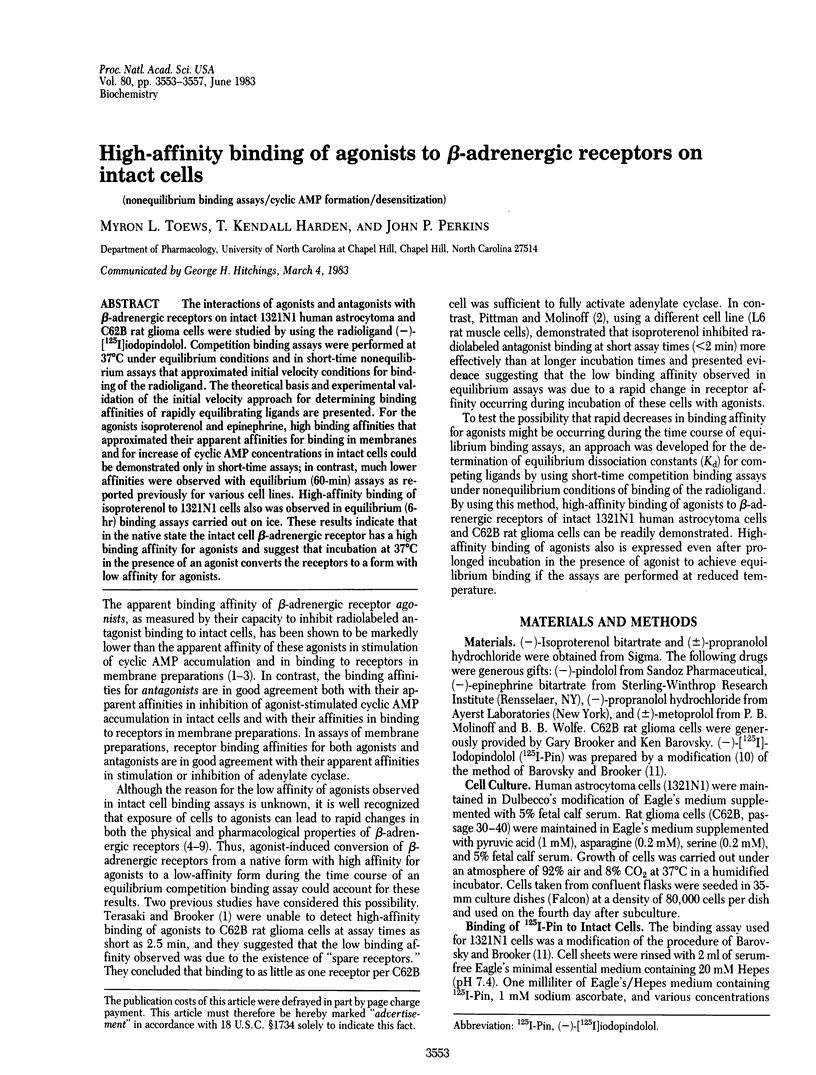
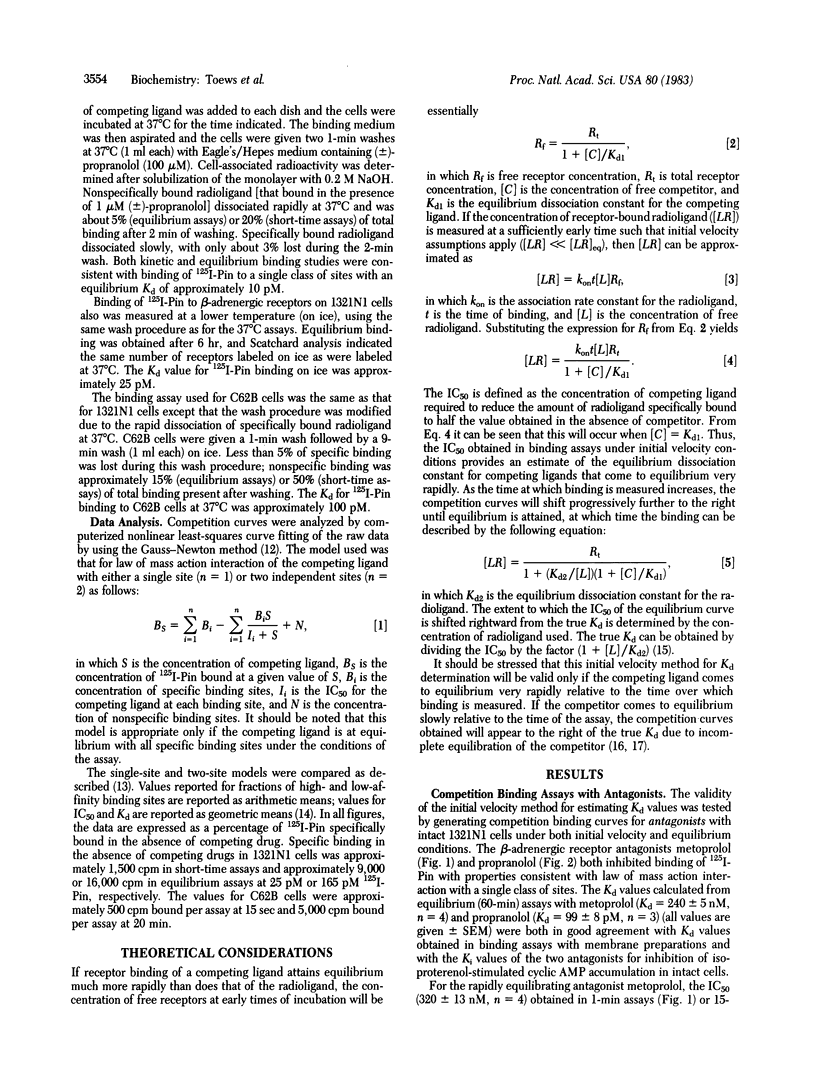
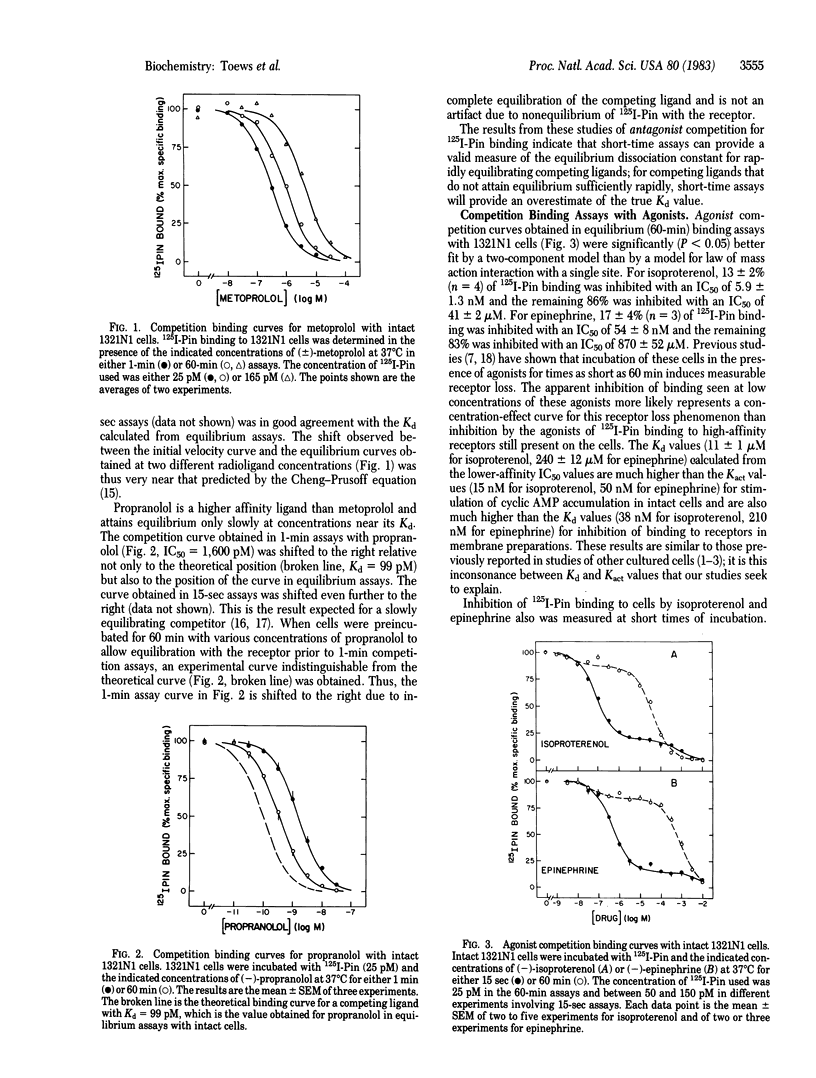
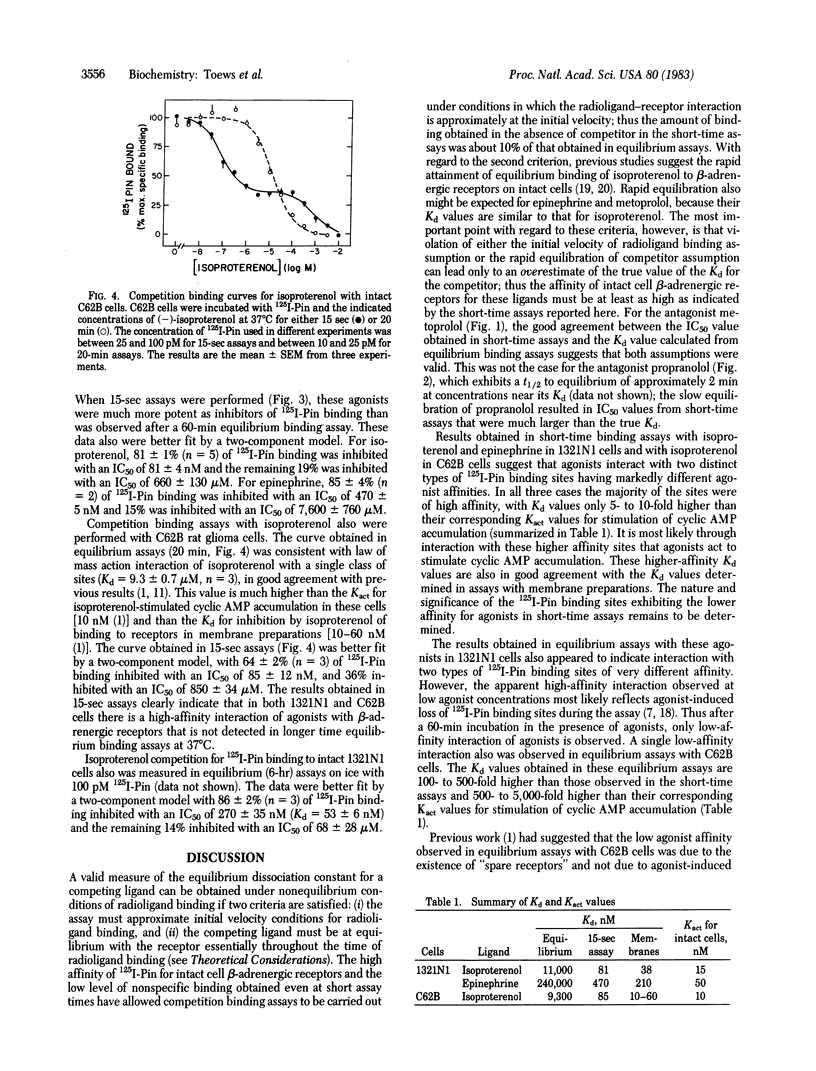
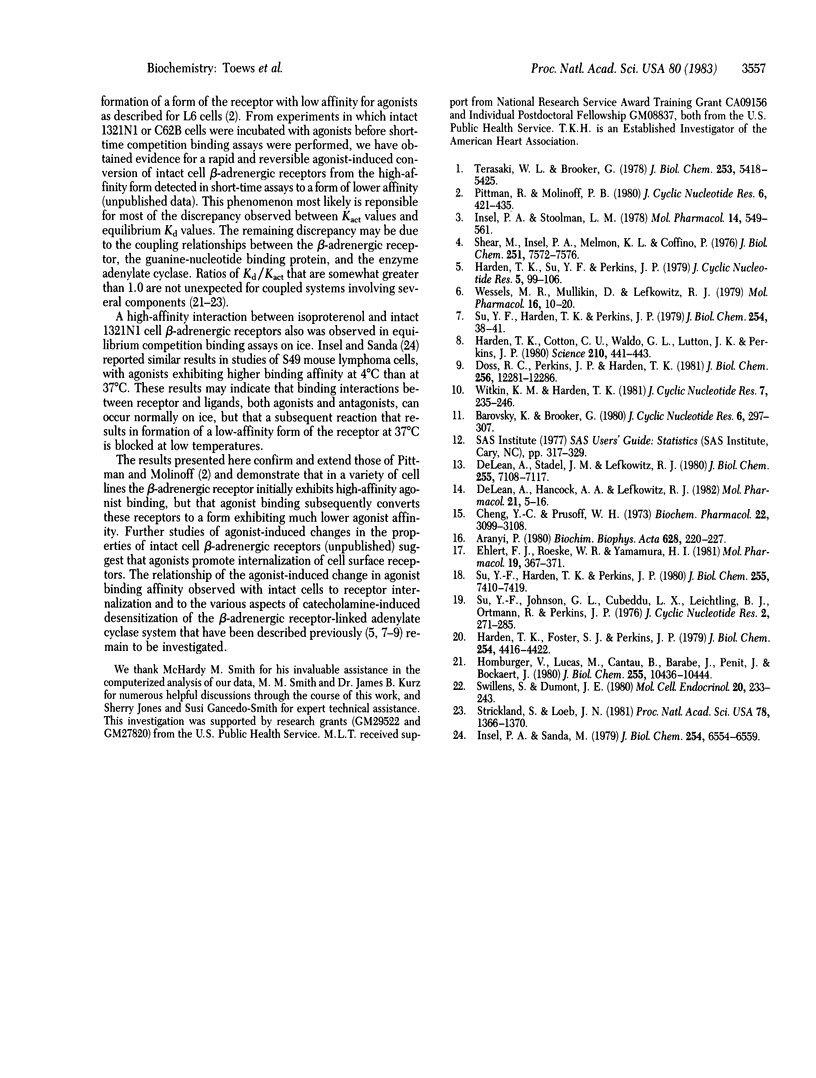
Selected References
These references are in PubMed. This may not be the complete list of references from this article.
- Arányi P. Kinetics of the hormone-receptor interaction. Competition experiments with slowly equilibrating ligands. Biochim Biophys Acta. 1980 Mar 3;628(2):220–227. doi: 10.1016/0304-4165(80)90369-4. [DOI] [PubMed] [Google Scholar]
- Barovsky K., Brooker G. (-)-[125I]-iodopindolol, a new highly selective radioiodinated beta-adrenergic receptor antagonist: measurement of beta-receptors on intact rat astrocytoma cells. J Cyclic Nucleotide Res. 1980;6(4):297–307. [PubMed] [Google Scholar]
- Cheng Y., Prusoff W. H. Relationship between the inhibition constant (K1) and the concentration of inhibitor which causes 50 per cent inhibition (I50) of an enzymatic reaction. Biochem Pharmacol. 1973 Dec 1;22(23):3099–3108. doi: 10.1016/0006-2952(73)90196-2. [DOI] [PubMed] [Google Scholar]
- De Lean A., Hancock A. A., Lefkowitz R. J. Validation and statistical analysis of a computer modeling method for quantitative analysis of radioligand binding data for mixtures of pharmacological receptor subtypes. Mol Pharmacol. 1982 Jan;21(1):5–16. [PubMed] [Google Scholar]
- De Lean A., Stadel J. M., Lefkowitz R. J. A ternary complex model explains the agonist-specific binding properties of the adenylate cyclase-coupled beta-adrenergic receptor. J Biol Chem. 1980 Aug 10;255(15):7108–7117. [PubMed] [Google Scholar]
- Doss R. C., Perkins J. P., Harden T. K. Recovery of beta-adrenergic receptors following long term exposure of astrocytoma cells to catecholamine. Role of protein synthesis. J Biol Chem. 1981 Dec 10;256(23):12281–12286. [PubMed] [Google Scholar]
- Ehlert F. J., Roeske W. R., Yamamura H. I. Mathematical analysis of the kinetics of competitive inhibition in neurotransmitter receptor binding assays. Mol Pharmacol. 1981 May;19(3):367–371. [PubMed] [Google Scholar]
- Harden T. K., Cotton C. U., Waldo G. L., Lutton J. K., Perkins J. P. Catecholamine-induced alteration in sedimentation behavior of membrane bound beta-adrenergic receptors. Science. 1980 Oct;210(4468):441–443. doi: 10.1126/science.6254143. [DOI] [PubMed] [Google Scholar]
- Harden T. K., Foster S. J., Perkins J. P. Differential expression of components of the adenylate cyclase system during growth of astrocytoma cells in culture. J Biol Chem. 1979 Jun 10;254(11):4416–4422. [PubMed] [Google Scholar]
- Harden T. K., Su Y. F., Perkins J. P. Catecholamine-induced desensitization involves an uncoupling of beta-adrenergic receptors and adenylate cyclase. J Cyclic Nucleotide Res. 1979;5(2):99–106. [PubMed] [Google Scholar]
- Homburger V., Lucas M., Cantau B., Barabe J., Penit J., Bockaert J. Further evidence that desensitization of beta-adrenergic-sensitive adenylate cyclase proceeds in two steps. Modification of the coupling and loss of beta-adrenergic receptors. J Biol Chem. 1980 Nov 10;255(21):10436–10444. [PubMed] [Google Scholar]
- Insel P. A., Sanda M. Temperature-dependent changes in binding to beta-adrenergic receptors of intact S49 lymphoma cells. Implications for the state of the receptor that activates adenylate cyclase under physiological conditions. J Biol Chem. 1979 Jul 25;254(14):6554–6559. [PubMed] [Google Scholar]
- Insel P. A., Stoolman L. M. Radioligand binding to beta adrenergic receptors of intact cultured S49 cells. Mol Pharmacol. 1978 Jul;14(4):549–561. [PubMed] [Google Scholar]
- Pittman R. N., Molinoff P. B. Interactions of agonists and antagonists with beta-adrenergic receptors on intact L6 muscle cells. J Cyclic Nucleotide Res. 1980;6(6):421–435. [PubMed] [Google Scholar]
- Shear M., Insel P. A., Melmon K. L., Coffino P. Agonist-specific refractoriness induced by isoproterenol. Studies with mutant cells. J Biol Chem. 1976 Dec 10;251(23):7572–7576. [PubMed] [Google Scholar]
- Strickland S., Loeb J. N. Obligatory separation of hormone binding and biological response curves in systems dependent upon secondary mediators of hormone action. Proc Natl Acad Sci U S A. 1981 Mar;78(3):1366–1370. doi: 10.1073/pnas.78.3.1366. [DOI] [PMC free article] [PubMed] [Google Scholar]
- Su Y. F., Harden T. K., Perkins J. P. Catecholamine-specific desensitization of adenylate cyclase. Evidence for a multistep process. J Biol Chem. 1980 Aug 10;255(15):7410–7419. [PubMed] [Google Scholar]
- Su Y. F., Harden T. K., Perkins J. P. Isoproterenol-induced desensitization of adenylate cyclase in human astrocytoma cells. Relation of loss of hormonal responsiveness and decrement in beta-adrenergic receptors. J Biol Chem. 1979 Jan 10;254(1):38–41. [PubMed] [Google Scholar]
- Su Y. F., Johnson G. L., Cubeddu L., Leichtling B. H., Ortmann R., Perkins J. P. Regulation of adenosine 3':5'-monophosphate content of human astrocytoma cells: mechanism of agonist-specific desensitization. J Cyclic Nucleotide Res. 1976 Jul-Aug;2(4):271–285. [PubMed] [Google Scholar]
- Swillens S., Dumont J. E. Non-linear coupling between receptor occupancy and biologic effect as a requirement for a higher drug efficacy. Mol Cell Endocrinol. 1980 Dec;20(3):233–242. doi: 10.1016/0303-7207(80)90039-8. [DOI] [PubMed] [Google Scholar]
- Terasaki W. L., Brooker G. [125I]Iodohydroxybenzylpindolol binding sites on intact rat glioma cells. Evidence for beta-adrenergic receptors of high coupling efficiency. J Biol Chem. 1978 Aug 10;253(15):5418–5425. [PubMed] [Google Scholar]
- Wessels M. R., Mullikin D., Lefkowitz R. J. Selective alteration in high affinity agonist binding: a mechanism of beta-adrenergic receptor desensitization. Mol Pharmacol. 1979 Jul;16(1):10–20. [PubMed] [Google Scholar]
- Witkin K. M., Harden T. K. A sensitive equilibrium binding assay for soluble beta-adrenergic receptors. J Cyclic Nucleotide Res. 1981;7(4):235–246. [PubMed] [Google Scholar]


